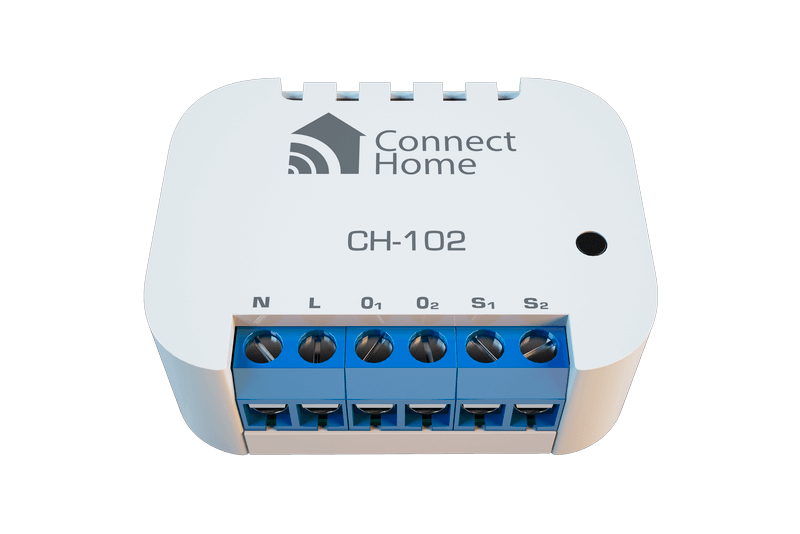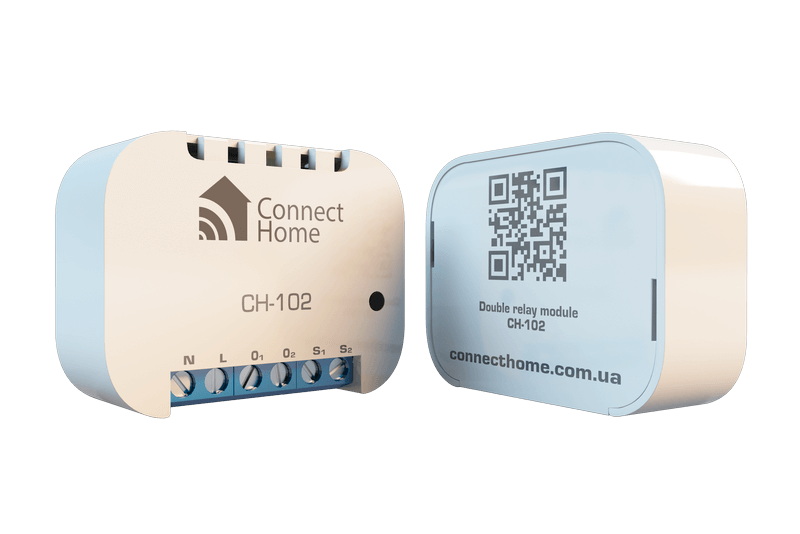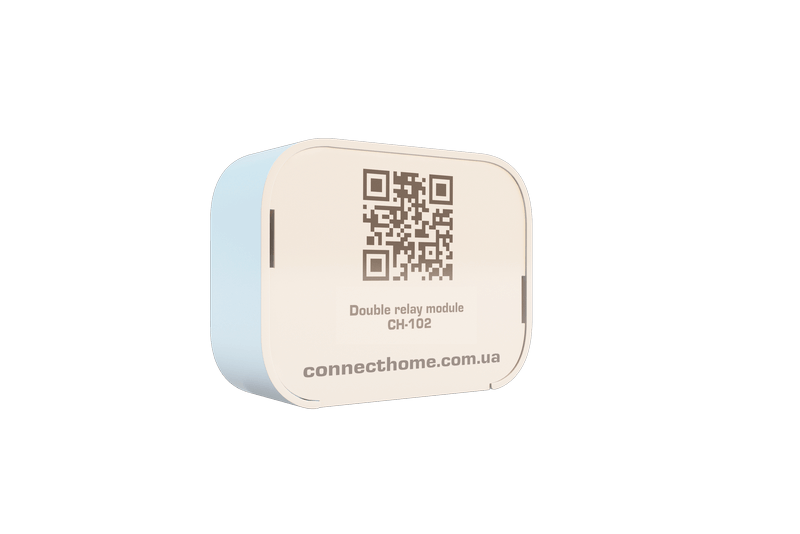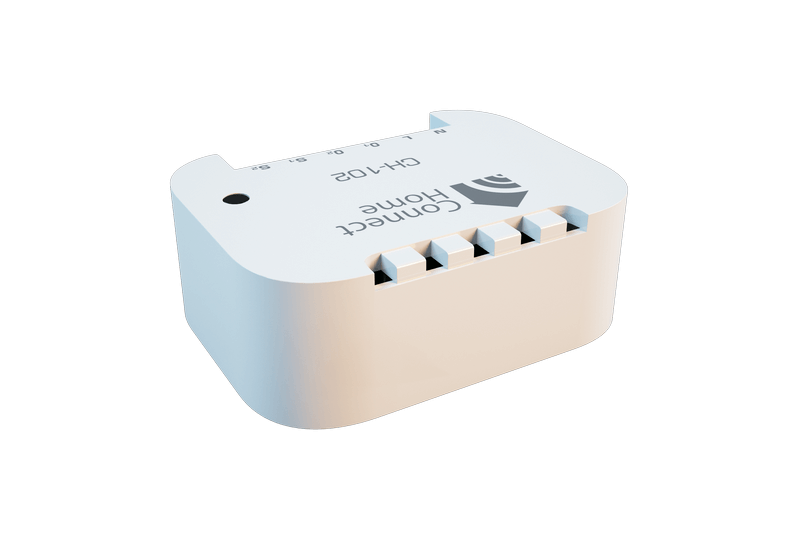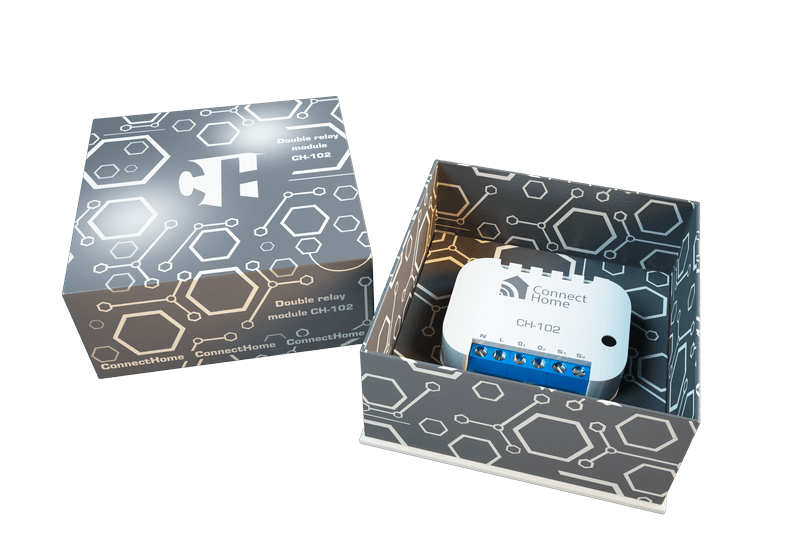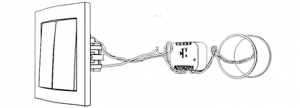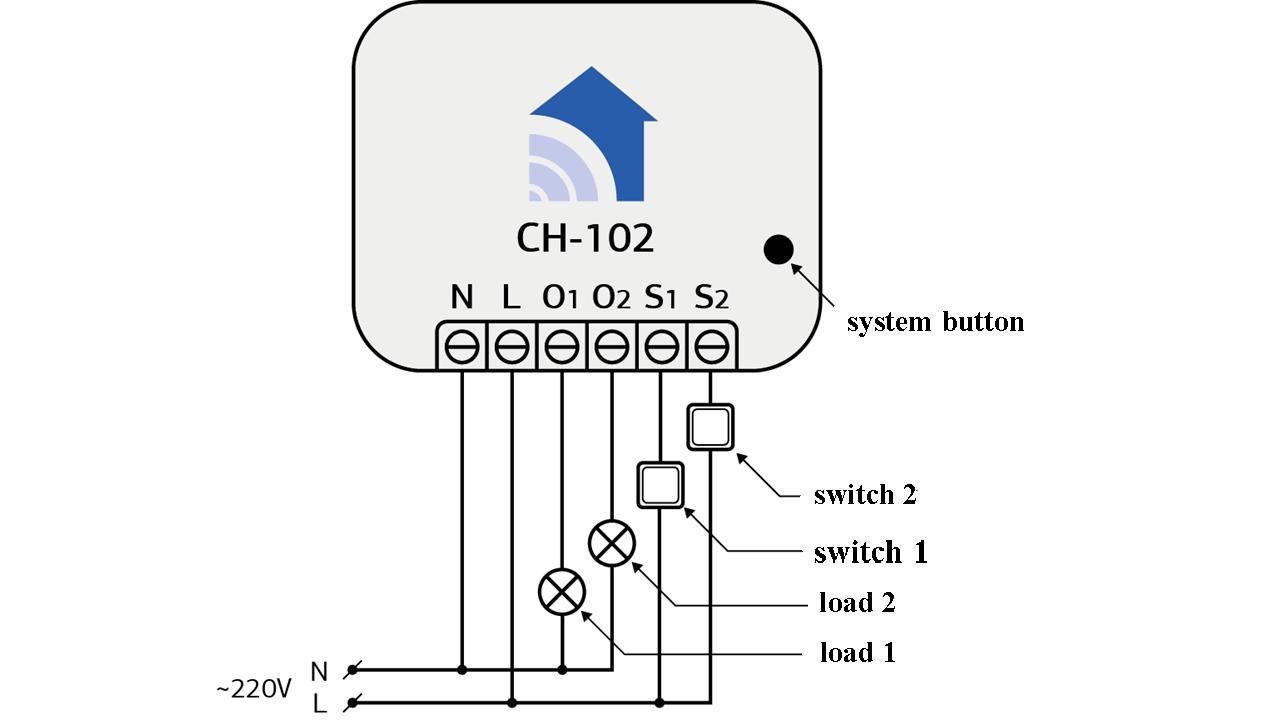Multifunctional single-channel module СН-102 - is a device that can control two independent 220V mains loads up to 1.7 kW. The device can be controlled either by means of switches connected to it or by means of radio commands. The size of the module is so small that it can even be placed in a junction box behind the circuit breaker (Fig. 1).
Application of the module:
- lighting control
- climate control
- control of any electrical load
Technical Specifications
| Nominal supply voltage | 110 — 250 V AC 50/60 Hz |
| Maximum AC resistive load current | 8A / 230V 50/60 Hz — AC1(cos φ ≥ 0.95) |
| Maximum AC inductive load current | 8A / 230V 50/60 Hz — AC3(cos φ ≥ 0.4) |
| Maximum current of the switched DC load | 8A / 30 V — DC-1 |
| Maximum switching voltage | 230VAC/30VDC |
| Operating temperature | -10 °C to 50 °C |
| Radio signal strength | 2 mW |
| Radio frequency | 868,4 MHz EU; 869,2 MHz RU; |
| Indoor range | Up to 45 m |
| Operating radius in open space | Up to 75 m |
| Power consumption | < 0.72W |
| Module dimensions | 18*48*37 мм |
| Minimum relay life | 50,000 tap-change operations |
| Protection level | IP-30 |
Adding a module to the central controller
To add the module module into the network, put the controller into teaching mode (see the manual of your controller) and apply power to the electrical network to which the device is connected. The device will be added automatically . If this does not happen automatically, press the system button on the top cover of the unit three times briefly.
Attention! If there is a problem connecting the device to your network, you must go through the procedure of excluding it from the network and then repeat the power-on procedure.
To add removing (exclude) the module from the network, put the controller into exclusion mode (see the controller manual) and press the system button three times briefly. Please note, once the unit is excluded from the network, all the settings you made will be reset to the factory settings
You can also add/remove a device from the network with a switch which is connected to pin S1. If the switch is monostable (Parameter 15), then the addition/removal is done by triple pressing the switch for 2 seconds. If the switch is bistable (Parameter 15), the addition/removal takes place by successive combinations of switch on/off/on(1-0-1) or off/on(0-1-0) within 2 seconds.
Device control
The module can be controlled locally with a switch connected to it to contact S1 and S2. The switches can be either monostable (return or bell type) or bistable (standard switch with two fixed positions). To select the type of switch, set the corresponding value in Parameters 15 and 16.
Connecting the device
Attention! This device is powered by 230 V 50 Hz. Observe safety rules during installation/dismantling of the device. Before starting the installation, it is necessary to de-energize the electric network and the protection against accidental energizing of the network must be provided. Electrical installation work must be carried out by a qualified electrician in accordance with current regulations. If problems arise or if the installer cannot ensure safe operation during the installation, immediately de-energize the unit and the equipment connected to it.
Consider the fact that the module generates a small amount of heat during normal operation. Take measures to ensure normal heat dissipation. Do not install more than one module together in a confined space, and do not allow the module to be enclosed in insulating materials.
Electrical wiring diagram.
Diagram of connection of the CH-102
Description:
- L - Phase
- N - Neutral wire
- О1 — Нагрузка 1
- О2 — Нагрузка 2
- S1 - Contact for Switch 1
- S2 — Контакт для Выключателя 2
Parameters
The CH-102 is a so-called "boxed product". This means that you just need to take it out of the box, plug it in and the device is ready to work. But for your convenience, you can fine-tune the device with a number of configuration parameters.
Relay operation parameters
Relay #1 can operate in 3 states: This parameter allows the relay to be switched off when receiving an on command, and to be switched on when it is switched off. This can be used in cases where the logical activation implies an open relay and vice versa (normally open valves, security systems, etc.). In addition, the relay can be used in various cyclic processes where the normal operation of the relay is to turn on and off at a given interval (e.g. blinking of the light security siren, etc.). 0. Operation in normal mode (Default);
1. Operation in reverse mode;
2. Blink.
The unit of measure used in the parameter is 0.1 second (10 = 1 second). The allowable value is 1-65000; 10 (Default). The unit of measure used in the parameter is 0.1 seconds (10 = 1 second). The permissible value is 1-65000; After receiving the activation signal, relay 1 will automatically deactivate after the set time. The unit used in the parameter is 0.1 second (10 = 1 second). Pressing the "Off" switch key will deactivate the relay instantly. If you select the value "0" in the parameter, the autoreclosing does not work. Valid values: 1-65000. ● 0 (Default). After receiving the activation signal, relay 1 will automatically deactivate after the set time. The unit used in the parameter is 0.1 second (10 = 1 second). Pressing the "Off" switch key will deactivate the relay instantly. If you select the value "0" in the parameter, the autoreclosing does not work. Valid values: 1-65000. 0 (Default). After receiving the switch-off signal, relay 1 will not switch off immediately, but after a preset time (Smart delay). The unit of measure used in the parameter is 0,1 second (10 = 1 second). In parameter #18 you can select the cases in which the relay will ignore the Smart delay. The permissible value is 1-65000; 0 (Default). If you want relay 2 to be restored to its previous state after a power failure, select "Restore". If you want it to be switched off after a power failure, select "Do not restore". 0. Restore (Default); The parameter allows you to set whether the module reacts to the broadcast commands "Enable All" and "Disable All". 0. Respond to Enable All command, Respond to Disable All command (Default); Relay #2 can operate in 3 states: The parameter allows the relay to be switched off when receiving an on command, and vice versa when it is switched off. This can be used in cases where the logical switch-on implies an open relay and vice versa (normally open valves, security systems, etc.). In addition, the relay can be used in various cyclic processes where the normal operation of the relay is to switch on and off at specified intervals (e.g. blinking of the light security siren, etc.). 0. Operation in normal mode (Default); After receiving the activation signal, relay #2 will automatically deactivate after the set time. The unit used in the parameter is 0.1 second (10 = 1 second). Pressing the "Off" switch key will deactivate the relay instantly. If you select the value "0" in the parameter, the auto shutdown does not work. Valid values: 1-65000. 0 (Default). After receiving the command to turn on, relay 2 will not turn on immediately, but after a certain time. The units used in the parameter are 0.1 seconds (10 = 1 second). If the value "0" is selected in the parameter - the activation delay does not work. The permissible value is 1-65000; 0 (Default). After receiving the switch-off signal, relay 2 will not switch off immediately, but after a preset time (Smart delay). The unit used in the parameter is 0.1 second (10 = 1 second). In parameter #18 it is possible to select the cases in which the relay will ignore the Smart delay. 0 (Default). If you want relay 2 to be restored to its previous state after a power failure, select "Restore". If you want it to be switched off after a power failure, select "Do not restore". 0 (Default). 1 Do not restore. After applying power, the device will be in the "Off" state. Monostable - for a return-type switch or for a button, each press switches the device to the opposite state. 0. Monostable - in this mode, each subsequent push of the button switches the device to the opposite state. Monostable switches support the function of controlling dimmers and roller shutter modules. By pressing and holding the monostable switch, the associated dimming/position change command will be sent to the associated roller shutter dimming/position change, by releasing the button the desired level can be selected; 1. Bistable - each subsequent switch change will change the state of the relay (on/off) regardless of the initial key position (Default); 2. Bistable, fixed position (Option 1) (contacts on the switch closed - relay on, open - relay off); Note that if the module receives a command from another device in the network, the relay will change its state and must first be reset to the appropriate state to control the breaker. 3. Bistable, fixed position (Variant 2). Similar to the previous one, but vice versa (contacts on the switch are closed - relay off, open - relay on). 0. Monostable. In this mode, each subsequent press of the switch switches the device to the opposite state. Monostable switches support the function of controlling dimmers and roller shutter modules. Pressing and holding the monostable switch will send a start dimming/position change command to the associated dimmers/roller modules, releasing the button will select the desired level. 1. Bistable - each subsequent switch changeover will send an on/off command to devices from the 3rd group of links, regardless of the initial switch position (Default). 2. Bistable, fixed position (Variant 1) (contacts on the switch are closed - on command, open - off command). 3. Bistable, fixed position (Option 2). Similar to the previous one, but vice versa (contacts on the switch are closed - relay off, open - relay on). This option will allow you to configure the "Smart Hold" in more detail. - local switches; 0 - Respond to "Smart Hold" (Parameter 6), whichever way the "Off" command is received; - Devices that are not in the 1st group of connections; If a shutdown command is received from the local S1 switch or the controller, the module will shut down immediately. 2 - Respond to the "Smart Hold" if you receive a "Shutdown" command from: - Devices that are not in the 1st group of connections; If an "Enable" command is received from a local switch or controller, the relay will stop communicating with the sensor and will not turn off until it receives a "Disable" command from the local switch or controller. The CH-102 module supports transmission of radio commands in a secure mode (Security Command Class). Security Command Class is the transmission of control commands using 128-bit AES hardware encryption. This allows the device to be fully protected from unauthorized operation. Refer to your controller's manual for support of secure mode devices. 0 - Respond both to a command sent in secure mode and to an ordinary command (Default); 1 - Respond only to a command sent in security mode. [spoiler title=’Parameter 51 - which command to send to devices from the 2nd group of connections. 0 - When you press button 1, send a normal command to the 2nd group of links (Default); 1 - When button 1 is pressed, send a safe command to the 2nd group of connections. 0 - When a binary sensor is triggered (S2), send the normal command to the 3rd group of links (Default); 1 - When a binary sensor (S2) is triggered, send a safe command to the 3rd group of links.
● 10 (Default).
1. Do not restore. After applying power, the device will be in the "Off" state.
1. Ignore the "Turn All On" command, Ignore the "Turn All Off" command;
2. Ignore the "Turn All On" command, Respond to the "Turn All Off" command;
3. Respond to the "Turn All On" command, Ignore the "Turn All Off" command.
1. Operation in reverse mode;
2. Blink.Operation parameters of pushbuttons/switches
Bistable - for conventional switches with two fixed On and Off positions.
The module can receive an on/off command from:
- controller (devices from the 1st group of connections);
- other devices using communication;
- of the sensor connected to the module when the module is combined with the sensor (Parameter No. 21, value 1 or 2)
1 - (Default) Respond to "Smart Hold" if you receive a "Shutdown" command from:
- Sensors connected to the module.
- Sensors connected to the module.Device parameters in safe mode
Device Connections
Devices can communicate with each other as well as exchange data and other information both with the central controller and directly without the controller. Each event can have its own list of recipients, called a group of links. Refer to your controller's user manual to configure the links.
- Group 1 - device (controller is recommended), which will receive reports on changes of relay state and data from sensors connected to the device. The size of the group is 3 devices;
- Group 2 - devices, which will receive the appropriate command when you press Switch 1 connected to contact S1. The size of the group is 10 devices;
- Group 3 - devices, which will receive the appropriate command when a binary sensor or switch connected to the binary input S2 is triggered. The size of the group is 10 devices;
Manufacturer's warranty.
The warranty period is 1 year from the date of sale. Products that were transported, stored, assembled and operated with violations of the requirements for these products, as well as having mechanical damage - warranty replacement is not subject to the warranty.
Do not use the unit in any way other than that specified in this manual. The manufacturer shall not be liable for any warranty in case of improper use, modification or painting of the device. Immediately after opening the package, be sure to check the device for damage. If there is visible damage, do not connect or use the device.
Briefly about the C-Home system
All C-Home devices use a reliable and completely safe radio channel, on the basis of which the modules are combined with each other in a single network, which allows you to receive and transmit control signals to other devices in the network, using intermediate neighboring nodes.
The C-Home system has the ability to automatically reconstruct data transmission routes, depending on external factors, for example, if there is an obstacle between two neighboring devices, the signal will go through other nodes in the network in range.
C-Home is a two-way network. The devices can not only send control commands, but also wait for confirmation of their delivery and query the current status of the device. If the sending was not successful, the system tries to send the command another way.
The central element of the C-Home network is the Butler, which stores information about the network topology. It allows you to add and remove devices from the network and control all devices remotely. Not only C-Home company devices, but also more than 4,500 devices of various types and manufacturers can be connected to the Butler, which enables the implementation of any home automation tasks.

